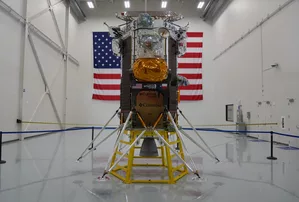Intuitive Machines’ First Lunar Lander Touches Down on Moon
The first American spacecraft to land on the lunar surface in more than 50 years, Intuitive Machines’ uncrewed lander, Odysseus, successfully touched down at the lunar South Pole early Friday morning. The spacecraft carries NASA science and other commercial payloads to the moon, marking a significant milestone in space exploration and technology advancement.
The lunar lander, named Odysseus, landed at the lunar South Pole on Thursday at 6.23 p.m. Eastern Time (4.53 a.m. India time), according to NASA. This historic mission marks Intuitive Machines’ first robotic flight to the moon’s surface, and it aims to study plume-surface interactions, radio astronomy, and space weather interactions with the lunar surface, as well as demonstrate precision landing technologies and communication and navigation node capabilities.
The spacecraft was launched on a SpaceX Falcon 9 rocket from NASA’s Kennedy Space Center in Florida, under the mission codenamed IM-1. This mission is part of NASA’s Commercial Lunar Payload Services initiative, which aims to deliver science and technology to the lunar surface in partnership with several US companies. The last US moon landing mission was made in December 1972, when Apollo 17 touched down on the lunar surface for the final mission of the Apollo Programme.
In January, another NASA-backed company, Astrobiotic Technology’s lunar lander suffered “critical” fuel loss and could not make it to the Moon. Odysseus’ successful landing represents a significant step forward in achieving NASA’s goals for lunar exploration and paving the way for future Artemis missions. This mission highlights the growing collaboration between government agencies and private companies in advancing space exploration and technology.
The successful touchdown of Intuitive Machines’ lunar lander, Odysseus, represents a historic achievement in space exploration and technology advancement. This mission carries significant scientific objectives and demonstrates the growing collaboration between government agencies and private companies in advancing space exploration. With the potential for future Artemis missions, this mission marks a significant milestone in space exploration and paves the way for future advancements in lunar exploration and technology.

 Jasmine Crockett Net Worth 2024: How Much is the United States Representative Worth?
Jasmine Crockett Net Worth 2024: How Much is the United States Representative Worth? New COVID-19 Variant Alert! KP.2 Can Bypass Your Immunity—How You Can Protect Yourself, Learn Everything
New COVID-19 Variant Alert! KP.2 Can Bypass Your Immunity—How You Can Protect Yourself, Learn Everything #Blockout2024: Why are A-Grade Celebrities Being Blocked And Reported On Social Media?
#Blockout2024: Why are A-Grade Celebrities Being Blocked And Reported On Social Media? Burnsview Secondary School Placed Under Lockdown For Prank Call, Investigation Underway
Burnsview Secondary School Placed Under Lockdown For Prank Call, Investigation Underway  Flagstaff Shooting At Bushmaster Park In Arizona, Armed and Dangerous Suspect Arrested
Flagstaff Shooting At Bushmaster Park In Arizona, Armed and Dangerous Suspect Arrested Lawsuit Slapped Against Chicago-Area Teacher And High School For Childhood Sexual Abuse
Lawsuit Slapped Against Chicago-Area Teacher And High School For Childhood Sexual Abuse 10 YO Sammy Teusch from Indiana Killed Himself After Relentless Bullying At School
10 YO Sammy Teusch from Indiana Killed Himself After Relentless Bullying At School Taxi Drivers Welcome Ruling That Found City Of Ottawa Negligent In Allowing Uber To Operate
Taxi Drivers Welcome Ruling That Found City Of Ottawa Negligent In Allowing Uber To Operate